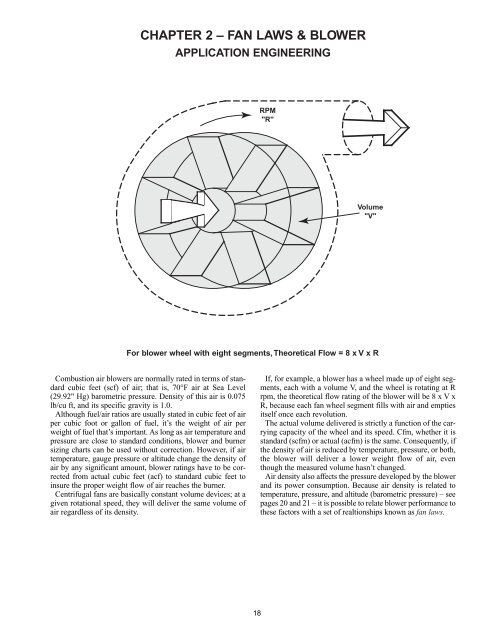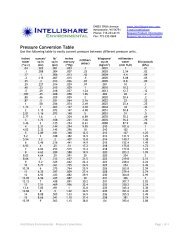Eclipse Engineering Guide
Eclipse Engineering Guide
Eclipse Engineering Guide
You also want an ePaper? Increase the reach of your titles
YUMPU automatically turns print PDFs into web optimized ePapers that Google loves.
CHAPTER 2 – FAN LAWS & BLOWER<br />
Combustion air blowers are normally rated in terms of standard<br />
cubic feet (scf) of air; that is, 70°F air at Sea Level<br />
(29.92" Hg) barometric pressure. Density of this air is 0.075<br />
lb/cu ft, and its specific gravity is 1.0.<br />
Although fuel/air ratios are usually stated in cubic feet of air<br />
per cubic foot or gallon of fuel, it’s the weight of air per<br />
weight of fuel that’s important. As long as air temperature and<br />
pressure are close to standard conditions, blower and burner<br />
sizing charts can be used without correction. However, if air<br />
temperature, gauge pressure or altitude change the density of<br />
air by any significant amount, blower ratings have to be corrected<br />
from actual cubic feet (acf) to standard cubic feet to<br />
insure the proper weight flow of air reaches the burner.<br />
Centrifugal fans are basically constant volume devices; at a<br />
given rotational speed, they will deliver the same volume of<br />
air regardless of its density.<br />
APPLICATION ENGINEERING<br />
18<br />
RPM<br />
"R"<br />
Volume<br />
"V"<br />
For blower wheel with eight segments, Theoretical Flow = 8 x V x R<br />
If, for example, a blower has a wheel made up of eight segments,<br />
each with a volume V, and the wheel is rotating at R<br />
rpm, the theoretical flow rating of the blower will be 8 x V x<br />
R, because each fan wheel segment fills with air and empties<br />
itself once each revolution.<br />
The actual volume delivered is strictly a function of the carrying<br />
capacity of the wheel and its speed. Cfm, whether it is<br />
standard (scfm) or actual (acfm) is the same. Consequently, if<br />
the density of air is reduced by temperature, pressure, or both,<br />
the blower will deliver a lower weight flow of air, even<br />
though the measured volume hasn’t changed.<br />
Air density also affects the pressure developed by the blower<br />
and its power consumption. Because air density is related to<br />
temperature, pressure, and altitude (barometric pressure) – see<br />
pages 20 and 21 – it is possible to relate blower performance to<br />
these factors with a set of realtionships known as fan laws.



